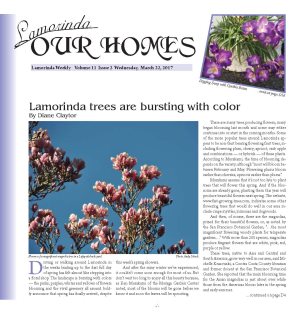| | Published March 22nd, 2017
| Lamorinda trees are bursting with color
| | | By Diane Claytor |  | | Flowers of a magnificent magnolia tree in a Lafayette back yard Photo Andy Scheck |
Driving or walking around Lamorinda in the weeks leading up to the first full day of spring has felt almost like stepping into a floral shop. The landscape is bursting with colors - the pinks, purples, whites and yellows of flowers blooming and the vivid greenery all around boldly announce that spring has finally arrived, despite this week's spring showers.
 And after the rainy winter we've experienced, it couldn't come soon enough for most of us. But don't wait too long to enjoy all this beauty because, as Ken Murakami of the Moraga Garden Center noted, most of the blooms will be gone before we know it and soon the leaves will be sprouting.
And after the rainy winter we've experienced, it couldn't come soon enough for most of us. But don't wait too long to enjoy all this beauty because, as Ken Murakami of the Moraga Garden Center noted, most of the blooms will be gone before we know it and soon the leaves will be sprouting.
 There are many trees producing flowers; many began blooming last month and some may either continue into or start in the coming months. Some of the more popular trees around Lamorinda appear to be non-fruit bearing flowering fruit trees, including flowering plum, cherry, apricot, crab apple and combinations - or hybrids - of these plants. According to Murakami, the time of blooming depends on the variety, although "most will bloom between February and May. Flowering plums bloom earlier than cherries, apricots earlier than plums."
There are many trees producing flowers; many began blooming last month and some may either continue into or start in the coming months. Some of the more popular trees around Lamorinda appear to be non-fruit bearing flowering fruit trees, including flowering plum, cherry, apricot, crab apple and combinations - or hybrids - of these plants. According to Murakami, the time of blooming depends on the variety, although "most will bloom between February and May. Flowering plums bloom earlier than cherries, apricots earlier than plums."
 Murakami assures that it's not too late to plant trees that will flower this spring. And if the blossoms are already gone, planting them this year will produce beautiful flowers next spring. The website, www.fast-growing-trees.com, indicates some other flowering trees that would do well in our area include crape myrtles, mimosas and dogwoods.
Murakami assures that it's not too late to plant trees that will flower this spring. And if the blossoms are already gone, planting them this year will produce beautiful flowers next spring. The website, www.fast-growing-trees.com, indicates some other flowering trees that would do well in our area include crape myrtles, mimosas and dogwoods.
 And then, of course, there are the magnolias, prized for their beautiful flowers, or, as noted by the San Francisco Botanical Garden, "...the most magnificent flowering woody plants for temperate gardens..." With more than 200 species, magnolias produce fragrant flowers that are white, pink, red, purple or yellow.
And then, of course, there are the magnolias, prized for their beautiful flowers, or, as noted by the San Francisco Botanical Garden, "...the most magnificent flowering woody plants for temperate gardens..." With more than 200 species, magnolias produce fragrant flowers that are white, pink, red, purple or yellow.
 These trees, native to Asia and Central and South America, grow very well in our area, said Michelle Krasowski, a Contra Costa County librarian and former docent at the San Francisco Botanical Garden. She reported that the main blooming time for the Asian magnolias is just about over while those from the Americas bloom later in the spring and early summer.
These trees, native to Asia and Central and South America, grow very well in our area, said Michelle Krasowski, a Contra Costa County librarian and former docent at the San Francisco Botanical Garden. She reported that the main blooming time for the Asian magnolias is just about over while those from the Americas bloom later in the spring and early summer.
 One of the most incredible magnolias around has to be the Soulangeana, or tulip magnolia, majestically towering in the backyard of Pat Doughty's Lafayette home. "The tree was large and amazing when I moved in 35 years ago," she said. "It just keeps on getting better." Two weeks ago, it was covered in beautiful and fragrant goblet-shaped pink flowers; by now, the delicate flower petals have faded to white and are covering the ground, replaced by green leaves that will provide shady spots for Doughty to enjoy all summer.
One of the most incredible magnolias around has to be the Soulangeana, or tulip magnolia, majestically towering in the backyard of Pat Doughty's Lafayette home. "The tree was large and amazing when I moved in 35 years ago," she said. "It just keeps on getting better." Two weeks ago, it was covered in beautiful and fragrant goblet-shaped pink flowers; by now, the delicate flower petals have faded to white and are covering the ground, replaced by green leaves that will provide shady spots for Doughty to enjoy all summer.
 Doughty insists she's not a gardener. "Anything I grow has to thrive on neglect," she said laughingly. She happily has a great arborist, who's "the only one I let touch this tree." Murakami said that young magnolias, like other immature plants, need "pretty religious watering and mulching." But as these trees age, they do become more self-sufficient and are moderately drought tolerant.
Doughty insists she's not a gardener. "Anything I grow has to thrive on neglect," she said laughingly. She happily has a great arborist, who's "the only one I let touch this tree." Murakami said that young magnolias, like other immature plants, need "pretty religious watering and mulching." But as these trees age, they do become more self-sufficient and are moderately drought tolerant.
 For Doughty, who planted two more magnolias so "I'll still have something to enjoy in case anything ever happens to this grand old tree," her magnolia is a way to celebrate springtime and entertain casually. Every year she invites friends and neighbors over for an informal afternoon to enjoy each other's company and share in the tree's beauty. "Everyone takes home cuttings from the tree so they can make their own floral arrangements," Doughty said. "Everyone typically leaves with a vase of buds, which in a day or two will open in a very dramatic way," allowing for some beautiful and creative floral centerpieces gracing her friends' homes.
For Doughty, who planted two more magnolias so "I'll still have something to enjoy in case anything ever happens to this grand old tree," her magnolia is a way to celebrate springtime and entertain casually. Every year she invites friends and neighbors over for an informal afternoon to enjoy each other's company and share in the tree's beauty. "Everyone takes home cuttings from the tree so they can make their own floral arrangements," Doughty said. "Everyone typically leaves with a vase of buds, which in a day or two will open in a very dramatic way," allowing for some beautiful and creative floral centerpieces gracing her friends' homes.
 While most people won't have the opportunity to delight in the beauty of Doughty's regal magnolia tree, a trip to San Francisco's Botanical Gardens will satisfy anyone's desire to view the tree's magnificence. Krasowski, the former docent, reports that the Gardens, with more than 200 elegant trees and over 40 different species, has the fourth largest collection of magnolias for conservation in the world. "It's the largest collection outside of Asia."
While most people won't have the opportunity to delight in the beauty of Doughty's regal magnolia tree, a trip to San Francisco's Botanical Gardens will satisfy anyone's desire to view the tree's magnificence. Krasowski, the former docent, reports that the Gardens, with more than 200 elegant trees and over 40 different species, has the fourth largest collection of magnolias for conservation in the world. "It's the largest collection outside of Asia."
 Unfortunately, the time for viewing these incredible plants is almost over. The Gardens' website notes that "the final major wave of Magnificent Magnolia blooms" will only last for another week or two. "It's a fantastic exhibit and I really encourage people to see it before it's all over," Kraswoski said. And if you want to stay closer to home, Murakami notes that Oakland's Mosswood Park also has some magnificent old magnolias.
Unfortunately, the time for viewing these incredible plants is almost over. The Gardens' website notes that "the final major wave of Magnificent Magnolia blooms" will only last for another week or two. "It's a fantastic exhibit and I really encourage people to see it before it's all over," Kraswoski said. And if you want to stay closer to home, Murakami notes that Oakland's Mosswood Park also has some magnificent old magnolias.

|
 | | Pat Doughty's mognolia tree Photo Andy Scheck |  | | | | | | | | | | | |







